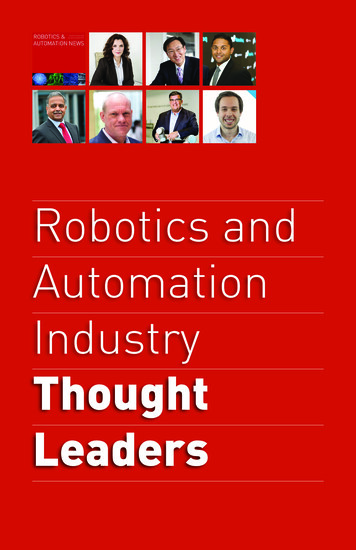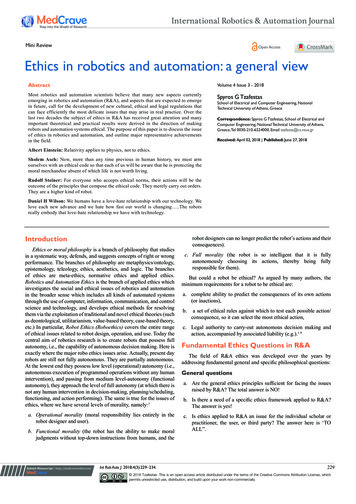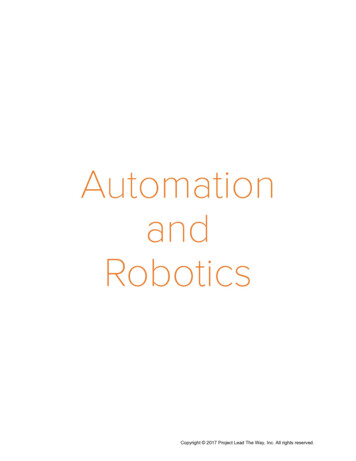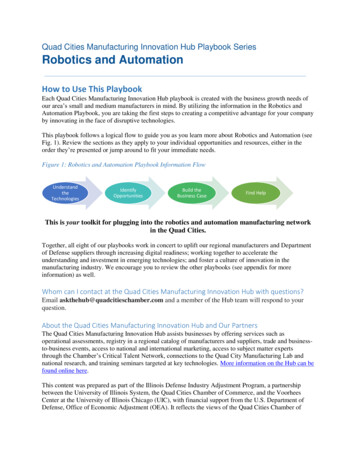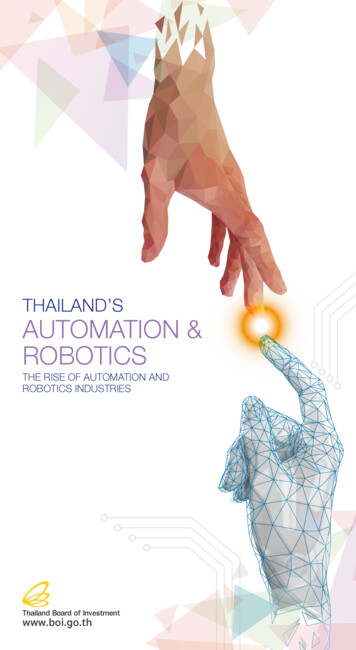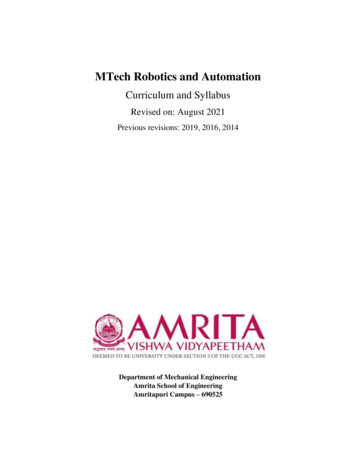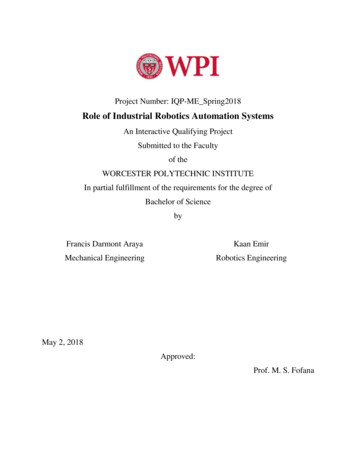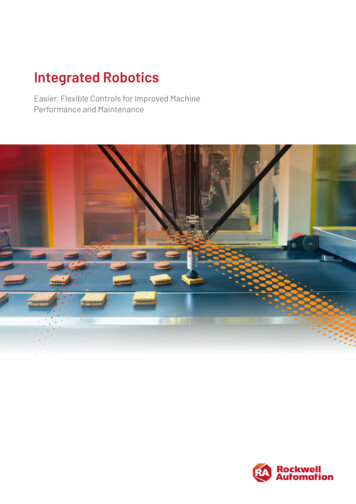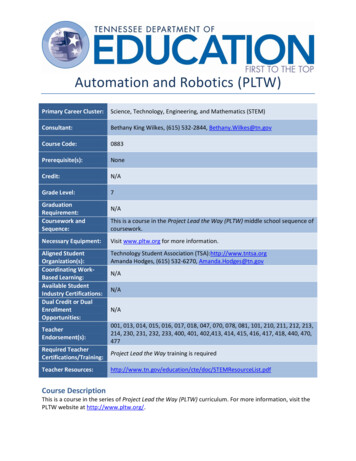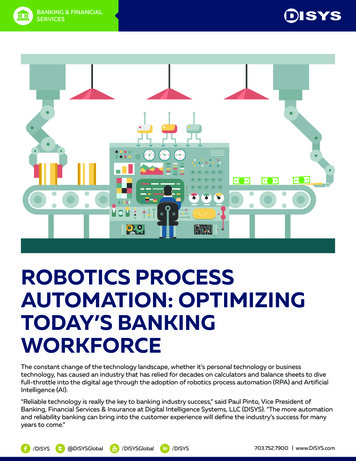
Transcription
BANKING & FINANCIALSERVICESROBOTICS PROCESSAUTOMATION: OPTIMIZINGTODAY’S BANKINGWORKFORCEThe constant change of the technology landscape, whether it’s personal technology or businesstechnology, has caused an industry that has relied for decades on calculators and balance sheets to divefull-throttle into the digital age through the adoption of robotics process automation (RPA) and ArtificialIntelligence (AI).“Reliable technology is really the key to banking industry success,” said Paul Pinto, Vice President ofBanking, Financial Services & Insurance at Digital Intelligence Systems, LLC (DISYS). “The more automationand reliability banking can bring into the customer experience will define the industry’s success for manyyears to 2.7900 www.DISYS.com
Although there is no official count, it isestimated there are more than 14,000 banksacross the world. A little more than 8,000 of thesebanks and credit unions are said to reside in theUnited States and they representapproximately 7.2% or 126 trillion of the US grossdomestic product.ways to lower costs in order to improve profitabilityand position themselves for long-term growth. ITorganizations within financial institutions are beingtasked to re-evaluate processes and theiroperations as returns on outsourced call centers,back office operations and loan processing decline.1“The more automation andreliability banking can bringinto the customer experience -especially on mobile devices -will define the industry’s successfor many years to come.”CIOs are looking for new ways to cut costs whilepositioning their organizations to improve serviceavailability and enhance the customer experience.The very real threat posed by Google and Applewho both have mobile pay systems presents anadditional layer of urgency for financial institutionsto accelerate innovation. These two tech giantsalready have untold amounts of customer data andare experts at manipulating the information to gaina stronger foothold. Some in the financial sectorbelieve, if it doesn’t make changes quickly, the ITgiants will begin offering other kinds of financialtransactions and accounts.3The banking system in the United States supportsthe world’s largest economy with the greatestdiversity in banking institutions and concentrationof private credit in the world.To remain relevant, financial institutions must takeadvantage of the rapid-fire changes in technologyemerging today. Otherwise, their competitive edgecould dissolve as tech companies win the loyalty ofthe young.4The financial industry is under pressure to make aninstitution’s services available 24/7 as profit margins shrink and customer satisfaction waivers.In 2015, a JD Power & Associates report statedATM satisfaction among consumers declined from2014 as mobile banking tools have increased.But customers are not entirely satisfied with thebreadth of services offered to them on the mobiledevices.In this paper, we will take a top-level look at RPAand AI, discuss its data and the importance ofstreamlining RPA analytics processes. We willalso explore the changes in the banking industryworkforce as it applies to the implantation of RPAand how this, instead of a negative, is a chancefor banking employees to get out from under themundane and find more fulfilling roles within theirorganizations.As customer expectations outpace technologyimprovements, the report states satisfaction withmobile banking and ATMs is dropping Customersexpect to be able to perform more functions on thesame device this year than they did last year andthey ”ease of use” is still king.The financial industry isunder pressure to make aninstitution’s services available24/7 as profit margins shrinkand customer satisfactionwaivers.‘Success will not be driven just by adding morebells and whistles,’ the report states, “But bybalancing functionality with ease of use and thenclearly communicating features and benefits to thecustomers.”2Banking organizations are under pressure to 074299-1.htmlPage 2/DISYS@DISYSGlobal/DISYSGlobal/DISYS703.752.7900 www.DISYS.com
“Success will not be driven just by adding more bells and whistles,but by balancing functionality with ease of use and then clearlycommunicating features and benefits to the customers.”The History of RPA & Its Data &AnalyticsRobotics Process Automation (RPA) is defined bythe Institute for Robotic Process Automation as‘the application of technology allowing employeesin a company to configure computer software or a‘robot’ to capture and interpret existingapplications for processing a transaction,manipulating data, triggering responses andcommunicating with other digital systems.’5The Institute continues by saying companies whouse large-scale labor forces, such as banking andfinancial institutions, for exorbitant amounts ofknowledge process work will benefit from RPA asit will boost their capabilities and save money andtime with its software.The premise behind robotics automation is that itgives any work process that is definable,repeatable, and rules-based the ability to map outa business process and assign a software robotto manage the execution of that process, just asa human would. RPA technology is not a part of acompany’s information technology infrastructure,but rather sits on top of it.“During the early 1990s, AI was taking over manyindustries especially manufacturing,” said DaveSufrinko, Director of DISYS’ Testing Practice. “Butits implementation within the financial sectorrepeatedly fell short because of the technologycosts and implementation problems.”One of the debates surrounding RPA revolvesaround the question of whether thistechnology is truly revolutionary or simply theproduct of the evolution of other similartechnologies. Many technologies, including artificialintelligence, expert systems, and other methods ofprocess automation have served as predecessorsto RPA. That being said, RPA takes artificialintelligence and expert systems to an elevatedlevel. Among leaders in the automation industry,robotic process automation is perceived as offeringunique capabilities and advantages over previoustechnologies such as artificial intelligence whichlargely fell flat in the financial industry during the1990s.76According to the Robotics Process AutomationHandbook, this allows a company to implement thetechnology quickly and efficiently without alteringexisting infrastructure and systems.Just as robots have and continue torevolutionize the manufacturing industry bycreating higher production rates and improvedquality, RPA is overhauling the way we think aboutadministrative business processes, supportprocesses, workflow processes, remoteinfrastructure and back-office work.5 -automation/6 /05/Robotic-Process-Automation-June2015.pdf7 /05/Robotic-Process-Automation-June2015.pdfPage 3/DISYS@DISYSGlobal/DISYSGlobal/DISYS703.752.7900 www.DISYS.com
“With today’s AI solutions,this data can be mined insuch a way that it is usefuland applicable to the dailyprocesses within financialinstitutions.”Experts agree the financial sector is at a crossroads:It is now required to take a look at RPA technologyand what it wants it to accomplish in the short andlong term.In recent years, several things have changed as thecost of computing has declined and the power of ithas improved tremendously. AI applications, whichtend to produce astronomical amounts of datathat requires storage, were not scalable to the pastyears – but currently the use of AI is more practicaland its data more manageable due to big data andcloud solutions.8“The fact AI produces so much data that could notbe mined properly, previously made implementingit a daunting task,” said Ray Goodwin, Testing andAutomation Expert at DISYS. “But with today’s AIsolutions, data can be mined in such a way that it isuseful and applicable to the daily processes withinfinancial institutions.”The ability to transform data into language turnswhat machines only previously understood intoinformation that banking leadership can easilyunderstand. The financial sector now has access toyears of data related to sales, products, divisionsand branch activities as well as customer opinionswhich improves leadership’s ability to makeinformed decisions.9RPA is a game-changer since it allowsorganizations to continually monitor business or ITprocesses and the behavior of personnel andsoftware applications as part of those processes.That monitoring of patterns and events isperformed by virtual engineers (robots) that canactually learn by observing process-basedactivities undertaken by human engineers.The subsequent knowledge gathered throughmachine observation can then be incorporated into future computer inferences made duringoperations. Not only can RPA be used to identifyan anomaly, thereby turning human workers intoproblem solvers, it can also initiate a set of actionitems to respond to the occurrence.10In the wealth advisory space, for instance, advisorscan access on demand, up-to-date tailored performance summaries for their clients, giving themknowledge they need to make better investmentrecommendations.11This understanding of the data AI technologymines through big data analytics and its accurateand valuable interpretation is what experts say isthe key to AI’s runaway success within the financialsector.“Using statistical analysis or machine learning, datacan now be used to discover relationships between8 lligence-use-in-financial-services/9 ial-intelligence10 /05/Robotic-Process-Automation-June2015.pdf11 ial-intelligencePage 4/DISYS@DISYSGlobal/DISYSGlobal/DISYS703.752.7900 www.DISYS.com
separate data points such as customerengagement, churn, transactions, sales and successlikelihood,” said Paul Francis, Director of DISYS’Business Intelligence Practice.outsourcing, the author states RPA stirs passionsat organizations that deploy technology with itspotential to slash jobs, shake up the relevant skillsmix and if implemented strategically, stave off thespecter of outsourcing.14Artificial Intelligence can then transform thediscoveries of those correlations into actualexplanations of identified relationships.12“While some have expressedconcerns robots are takingover jobs, what many fail torealize is the booming roboticsindustry is poised to open up amyriad of new positions.”But other key experts point out RPA in the bankingindustry will really only take away the lower-levelpositions including data entry, rekeying,assembling and formatting tasks and allowsinstitutions to re-task their talent in other moreimportant areas, offering further advancement andjob satisfaction.Think of it this way: When financial institutionsrelease AI software into systems to automatebusiness processes, that robot can in essence,bring back identifiable information on how aprocess performed. When an entire ‘army’ ofRPAs are deployed, it adds up to a significantamount of data – known as big data.“When information, brought back in the form ofbig data, is processed and analyzed, it puts thefinance industry in a position to discover bottlenecks and optimize processes,” said Paul Francis.Enter, analytics. Mounds of data used to meannothing to the naked eye and systems could notcomprehend or break the data down. But now,the use of big data analytics through proper RPAinstallations can pinpoint actionable tasks forimprovement and optimization.Turning large amounts of raw data into understandable patterns for institution decision-makingis where the true beauty of RPA is discovered.RPA & THE BANKING WORKFORCE13In a recent article in InfoWorld, which compares theRPA revolution to the earlier workforce upheaval of12131415An article in Tech Pro Essentials validates thetheory that the re-tasking of employees in moreprominent roles is a prime benefit of RPA implementation.“While some have expressed concerns robots aretaking over jobs, what many fail to realize is thebooming robotics industry is poised to open up amyriad of new positions,” the article states.“Historically, technology advancements havemeant certain careers become obsolete (RPA)can create new work related to (customer service)and operations – far outweighing the number ofjobs ployees/Page 5/DISYS@DISYSGlobal/DISYSGlobal/DISYS703.752.7900 www.DISYS.com
Through the incorporation of AI in the bankingworkplace, experts predict there will not only be anoutput of new jobs, but more fulfilling jobs.“Cutting costs through RPA also meanshigher-paying jobs in more professional positions,”said Al Barsoumian, Managing Director at DISYS.“RPA has been proven to lead to a happier workforce.”Through the delegation of tedious tasks, softwarerobots free up human workers to focus on morecreative, strategic and customer-facing roles –roles that are a better fit for people who are, bynature entrepreneurial and social.are taught correctly, they are always performedwithout mistakes.”Entrepreneur says: “Successful business leadersoften say they are only as strong as their teams.When you begin to think of robots as teammates,you can understand them as players that can makecompanies and industries stronger. So whenbusinesses gain competitive advantage by“staffing” with robots, you get higher salaries and ahappier (human) workforce.”17“The person sitting behind a desk all day pouringover spreadsheets doesn’t have to do that anymore,” Barsoumian said. “An employee’s energiesand talents can be redirected to benefit thecompany and the person’s career in an entirelydifferent way.”Entrepreneur magazine printed an opinion piecethrowing darts into the theory that RPA wasdestroying the financial industry’s workforce.What’s resulting with early adoption of (RPA) isthere’s room for both robots and people – and thecombination is enabling an unparalleled level ofefficiency, customer service and innovation, itstates.16“It is important to understand that people are stillinvolved in the process,” Pinto said. “People trainprocess robots much like they do new employees– teaching them the ins and outs of the job. Thedifference is the process itself doesn’t take aperson to trigger it and as long as those processesThrough the delegation oftedious tasks, software robotsfree up human workers tofocus on more creative,strategic and customer-facingroles.ABOUT DIGITAL INTELLIGENCESYSTEMS, LLC (DISYS)Digital Intelligence Systems, LLC (DISYS) is aglobal IT managed services and staffing firm with33 offices worldwide specializing in ManagedStaffing Services, Infrastructure Services,Application Development Services, BusinessIntelligence Services, Cloud Enablement Servicesand Enterprise Resource Planning. DISYS’ vision isto be a global business partner, delivering thehighest quality and most consistent services at thebest value to clients worldwide. For moreinformation about DISYS, visit http://disys.com.ABOUT DISYS’ BANKING,FINANCIAL SERVICES, ANDINSURANCE OFFERINGSDISYS’ Financial Services offering combines aproven automation and optimization approachwith repeatable assets to offer increased businessvalue to our partners. Our financial services clientshave benefitted from our catalog of intellectual16 http://www.entrepreneur.com/article/24165817 http://www.entrepreneur.com/article/241658Page 6/DISYS@DISYSGlobal/DISYSGlobal/DISYS703.752.7900 www.DISYS.com
property and our experience gathered on previousengagements. This means we can not only applylessons learned in other engagements to yourproject risk but we can more proactivelyrecommend solutions that are the best mix of tools,methodology and team structure toaccelerate productivity in your environment.Financial institutions continue to partner withDISYS to solve critical infrastructure andcompliance problems while reducing operatingexpenses – all amidst a rapidly-changing businesslandscape.FOR OUR FINANCIAL SERVICES CLIENTS,DISYS IS SOLVING THE FOLLOWING INDUSTRYCONCERNS:ACCESS TO NICHE TALENTFor our retail banking clients, DISYS’ customized,repeatable training processes & co-ownedtraining curricula are providing Pega CertifiedSystems Architects in high volume in response torapidly-changing BPM needs. Our Pegasystemsexperts are available in our clients’ most desiredlocations & are part of a robust development andretention program that includes partnerships withaccredited universities & a formal mentoringprogram. Benefits include decreased ramp-up time& guaranteed exceptional performance.OPERATIONAL EFFICIENCYDISYS’ infrastructure experts are deploying ServerVirtualization solutions that are proven, repeatableand compliant with financial industry regulations.With low-risk cost models, robot-enabled ongoingsupport, and proven experience, we are migratingclients’ servers 50% faster and at 30% cost savingsover manual migration.DATA TESTING INNOVATIONDISYS’ testing delivery accelerators are automatingup to 90% of client solutions and are repeatableacross engagements– reducing costs andoptimizing project scopes. Our technologyinnovation is helping clients increase deliveryefficiency while reducing risk and enabling moreflexible solutions.INCREASING BUSINESS VALUEDISYS has stewarded numerous clients throughthe transition from transactional resource management models to outcome-based, managed servicesolutions. DISYS’ managed service approach ishelping some of our largest clients mitigate projectrisk, increase productivity and reduce costs by upto 20%.Page 7/DISYS@DISYSGlobal/DISYSGlobal/DISYS703.752.7900 www.DISYS.com
process automation have served as predecessors to RPA. That being said, RPA takes artificial intelligence and expert systems to an elevated level. Among leaders in the automation industry, robotic process automation is perceived as offering unique capabilities and advantages over pr

